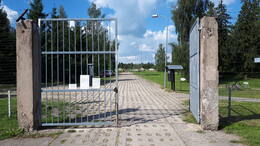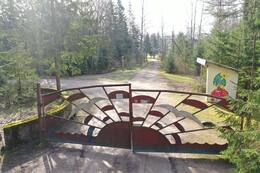Secret Veterinarian
Veterinary doctor Stanislovas Mikašauskas, who worked at the Plokštinė military base, shares his memories of unusual access to the base's territory and strict secrecy even in an informal environment.
The Plokštinė military base was a strictly guarded facility belonging to the Riga Military District. Stanislovas Mikašauskas, who worked as a veterinarian at the time, remembers an unusual entry into the base: "The commanders of the military base hired me as a veterinarian. The first time, a major came and said that they needed me immediately. They loaded me into a truck with firewood and brought me into the territory. They took me to the building where the pigs were, let me out. And after work, they led me through the fence into the forest."
Although the doctor signed official documents, he entered the base illegally. As he explains: "And if the pigs get sick, you won't wait." The military warned him: "If you get caught by any inspectors, you'll explain what you did, and everything will be fine. But know that you'll be stuck for two days until they figure out what kind of bird you are."
Even later, after becoming the chairman of the collective farm and hunting with the officers who served at the base, S. Mikašauskas did not approach the secrets of the base: "We used to hunt ducks together, but there was no talk about the base itself. We tried to ask, but they kept quiet. And some people talked about the tunnels, but it seems to me that if those tunnels had existed, someone would have passed through them anyway."
Related timeline
Related objects
Cold War exposition
On 31 December 1962, one of the first underground launch complexes for R-12 ballistic missiles in the Soviet Union, the Dvina underground launch complex, was put into operation
in Plokštinė Forest (Plungė district).
Between 1963 and 1978, four R12 medium-range ballistic missiles (SS-4 Sandal) equipped with a 2.3-megatonne nuclear warhead were deployed at the complex. All the missiles were aimed at Western European countries. This complex, together with similar surface-launched missile bases, formed a single Soviet nuclear arsenal in Lithuania, which was capable of destroying the whole of Europe. In its 16 years of operation, not a single missile was fired, despite the declaration of combat readiness during the Prague Spring in 1968.
After the Soviet soldiers left on 18 June 1978, the poorly guarded military facility was vandalised and looted. In 1993, when the complex was handed over to the Žemaitija National Park Directorate, its restoration began. In 2012, the Cold War exposition was opened. Today, this once very secret and guarded place is open to the public. A historical exposition on the Cold War period is on display at the former missile and equipment control room house. To date, it is the only museum in urope where a preserved underground missile launch silo is on display.
Plokštinė Military Town
In 1962, one of the first underground launch complexes for R-12 ballistic missiles in the Soviet Union, the Dvina, was put into operation in Plokštinė Forest (Plungė district).
A military camp was set up 0.5 km from the missile launch site. It occupied an area of 12 hectares, and approximately 30 buildings were built here for various purposes, including residential houses (barracks), officers’ headquarters, two canteens, a boiler house, a power station, a medical post, a club, a pig farm, warehouses, garages, and other structures.
The Plokštinė underground missile launching complex was operational until 18 June 1978. The Soviet soldiers left the area, taking only their weapons with them. In 1979, the management of the former military complex was transferred to the Republican Association of Agricultural Recreation Facilities of Plungė District, and the Plateliai Pioneer Recreation Camp “Žuvėdra” was established at the military campus site. The site was reconstructed and adapted to the needs of the camp, which operated until 1990. After the restoration of Lithuanian independence, the Pioneer Camp was closed.
Since 1993, the site has been managed by the Žemaitija National Park Directorate. In 2017, many of the structures on the military campus were demolished due to their state of disrepair. Today, there are about ten buildings left at the site, and visitors may see them from the outside. Information boards about the former buildings and their functions have been installed.






